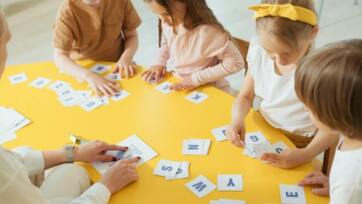Introduction
The seasonal learning quizzes allow teachers to link amusement with learning through interactive methods, which help students retain essential educational topics. Halloween-themed quizzes create academic fun and creative excitement for pupils in their classrooms. In these quizzes, the holiday elements, including macabre characters or dark environments, remain present while students develop their essential educational competencies. Halloween-oriented math questions and colour-based problems stimulate students' sense of wonder by promoting information memorization and problem-solving development as they enjoy the holiday atmosphere.

The Power of Themed Learning
Students stay focused on Halloween-themed learning activities because holidays create exciting learning opportunities. Students demonstrate increased engagement because learning material linked to relevant and enjoyable themes, such as holidays, typically leads to better educational attainment. Halloween-themed educational challenges unite subject content with an interactive setting to achieve student concentration during the task. Through its exciting graphics alongside theme-based challenges and relevant characters, the system develops an engaging educational space that reduces mental work for students.
Math Quizzes with a Halloween Twist
When teachers add seasonal elements to mathematical learning material, students view math lessons as less intimidating while becoming more involved. The problems presented in Halloween-themed math quizzes use subjects ranging from pumpkin number count to which flight ranges to determine the required number of monsters for a haunted property.
Incorporating Geometry into Halloween Challenges
Halloween-themed Geometry quizzes serve as an effective method of providing educational value to students. Teaching students includes designing activities to determine the dimensions of macabre haunted buildings and solve problems related to pumpkin area measurement. The activities enable students to study area, perimeter, and shape recognition through experiences that maintain their Halloween excitement. The educational content becomes more accessible when teachers design problems around Halloween-themed stories like haunted houses and pumpkin patch decorations.
Colour Challenges provides an entertaining approach to teaching students about colour theory.
Students find colour challenges exciting because they apply well to art and design classes. Colour challenges during Halloween provide two tasks to students. They need to identify Halloween character colours or pick appropriate design colour combinations for festival decorations. The teaching staff should create questions that let students’ pair colours to match moods: they should combine dark purples and black for Halloween themes yet pair bright oranges with yellows for pumpkin decorations. The planned activities allow students to learn colour principles through enjoyable and educational activities.
Incorporating Counting and Sorting with Halloween Characters
If you add spooky elements from Halloween to count and sort activities, students will find them fun. Students can organize Halloween-themed things such as candies and costumes or decorations according to size, shape, or colour classification. Students need to count Halloween elements during two main activities: determining the number of required pumpkins for decoration and the number of ghosts encountered in haunted houses. The quizzes allow students to enhance their counting capabilities while learning essential mathematical concepts of classification and grouping structure.
Problem-Solving with Spooky Scenarios
Halloween-themed quizzes enable students to resolve problems through math-based exercises. In their educational content teachers should design eerie scenarios which demand students to solve scary challenges by applying math skills and logical thinking abilities to traverse haunted domains or escape unpleasant monsters while calculating witches' potion requirements. These difficult activities enable students to improve their reasoning skills through enjoyable educational experiences. Students who participate in Halloween-themed puzzles must determine how many steps to take within mazes and solve these riddles to unlock new clues, thus developing creativity and analytical mastery.
Interactive Games for Halloween-Themed Quizzes
Interactive games with Halloween themes are beneficial for teaching students’ math and colour-related challenges. Kahoot! and Quizizz enable teachers to develop assigned quizzes featuring Halloween-oriented designs while utilizing timed question features. The educational activities allow students to compete with their peers through a fun process that simultaneously supports knowledge retention. Tech-enabled learning games enable students to experience the excitement of Halloween and improve their knowledge retention through gamified competitions.
Engaging Younger Learners with Simple Tasks
Educational activities for younger students should include basic Halloween math and colour assignments that align with their learning level. Teachers should develop straightforward addition and subtraction mathematics questions featuring Halloween objects like candy corn and skeletons. Students participate in colour challenges through tasks that ask them to identify or name the basic colours in Halloween accessories. Little tasks suited for early student ages keep children focused at school while practicing math fundamentals and colour identification. The quizzes are excellent for teaching pattern recognition through colour matching and object sequencing.
The teaching environment needs to be transformed into an appropriate Halloween setting.
The classroom environment should become spine-tingling to complement the entire Halloween learning environment. The classroom ambience transforms through decorations with cobwebs, pumpkins, and scary sounds, deeply immersing students in the Halloween theme. Transforming the educational space into a haunted environment leads students to develop increased engagement for Halloween-based quizzes. Students in an environment decorated by theme achieve better concentration levels while performing mathematics and colour-based quiz tasks.
The addition and subtraction teaching process integrates Halloween-themed activities.
Halloween-themed quizzes present an entertaining approach to teaching students essential addition and subtraction math concepts. During the addition teaching process, teachers might ask students to count witches in the air, while for subtraction problems, they can subtract bats from the scene. The combination of Halloween images illustrated in bright colours adds attractiveness to advanced mathematical issues, making them more interesting for students to study. The visual display of math problems supplemented by Halloween objects gives students a better understanding of mathematical concepts, particularly those related to addition and subtraction.
Exploring Fractions with Halloween Foods
Students learn fractions by dividing Halloween foods, including cakes, candies, and pizzas. For example, students need to divide pumpkin pie slices while determining the remaining portion of the pie after a specified number of pieces are consumed. The practice of fractions becomes more accessible to students when they use familiar examples that generate visual learning outcomes. The application of Halloween-themed fraction tasks facilitates tangible learning of abstract math concepts by giving students an interactive framework to understand fractions better.
Colour-Based Tasks Serve as an Effective Tool for Enhancing Fine Motor Ability
Colour-based tasks involving worksheet colouring with Halloween-shaped images help students effectively build their fine motor skills. During the colouring process, students who draw haunted houses, monsters, and pumpkins enhance their colour learning, improving coordination and accuracy. The tasks serve younger scholars well in developing their fine motor coordination abilities. Combining these activities helps teachers teach colour recognition through learning methods that merge educational standards with creative practice.
Learning Math through Spooky Stories
Educational Halloween-themed stories function as an effective way to reinforce various mathematical concepts in students. Teachers should develop spooky stories integrating numbers through examples like a witch needing a precise quantity of bats for her potion and a haunted house with ghost populations matching specific numbers. The students can apply their math skills to solve problems about the story by calculating the ghost population after any disappearances occur. Connecting math lessons to storytelling helps students understand the subject material better.
The Importance of Fun in Learning
Quizzes must guarantee educational quality, but learning should remain fun and engaging. Math and colour challenges that use Halloween-related themes allow students to experience educational activities as enjoyable and exciting events instead of ordinary classroom tasks. The joyful spirit of Halloween, involving costumes, decorations, and scary figures, enables math and colour quizzes to become lasting student memories. Educational entertainment becomes a powerful tool for teachers to establish classrooms full of motivated students who enthusiastically approach new learning opportunities.
Creating Custom Halloween-Themed Quizzes
Teachers possess the freedom to design Halloween-oriented quizzes that satisfy student learning requirements. Educators can develop quizzes of suitable difficulty that accommodate students across lower grades and higher academic levels by selecting challenges with different complexity ranges. Teachers can customize their quizzes to target particular learning targets, such as arithmetic enhancement or colour comprehension. Charitable quizzes allow customization based on student interests so learners experience them as individualized content that directly pertains to their learning needs.
Conclusion
Students embrace Halloween-themed math and colour challenges due to their educational effectiveness and ability to create an enjoyable learning environment. Teachers use festive school activities and educational material to create learning opportunities that combine subject matter knowledge with holiday joy, motivating students to learn math and colour theory and nurturing their innovation, analytical abilities, and problem-solving skills. Academic quizzes with thematic approaches create memorable learning experiences while bringing enjoyment to the classroom since well-constructed activities help students achieve their educational milestones.









